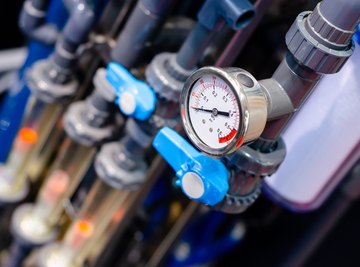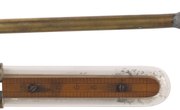
Current technology advances provide many computer-controlled tools for installing and maintaining pressurized systems, such as industrial steam boilers. However, simple tools remain effective and accurate, including the inclined manometer. This simple pressure-measuring tool allows workers to physically view a pressure quantity through the use of an internal liquid.
Inclined Manometer Features
An inclined manometer is a slightly curved tube with a liquid inside, typically a form of oil mixture. Along the tube's middle portion are graduations. The graduations are commonly hundredths of an inch, depending on the manometer's manufacturer. A user places the manometer in a gas draft flow. The pressure exerted by the flow presses against the internal liquid. The amount of liquid displacement is viewed and measured through the tube's graduations, producing a pressure value.
Benefits
The manometer's inclined angle provides many advantages. A small or low amount of pressure against the inclined manometer will produce a large liquid movement relative to the tube's graduations. As a result, the graduation scale can be very precise--down to a hundredth of an inch accuracy. In addition, the inclined manometer's simple design makes it an inexpensive, but accurate, tool for everyday gas-pressure measurement.
Sensitivity
Other manometer tools, such as the U Type, cannot register low-pressure quantities. The inclined manometer is essential for retaining the most accurate pressure levels for industrial gas applications. A low-pressure industrial gas system may be used to heat or cool manufacturing processes. A small blockage within the gas system can be detected with an inclined manometer and corrected. Other manometer types may not register the small blockage until the gas system becomes completely clogged, warranting a possibly costly repair.
Calibrating
The high accuracy of the inclined manometer makes it a precise tool for calibrating other tools, such as a specific pressure needed in an air-conditioning unit. The worker can place the inclined manometer into the air conditioner's air pressure flow. Subsequently, the worker can slowly adjust the air-conditioning system while monitoring the pressure reflected on the inclined manometer. As a result, the worker retains a precise air pressure through the air-conditioning system in a timely manner.
Parts
Inclined manometers do not have any parts that can wear or age, unlike mechanical or electronic manometer types. However, they must be protected from accidental drops. The tube is typically made from glass, providing an extremely transparent visual for the moving internal liquid. Any cracks or damage to the tube can alter the manometer's accuracy. Visually inspect the tubing before attempting to measure a pressure.
About the Author
Writing professionally since 2010, Amy Rodriguez cultivates successful cacti, succulents, bulbs, carnivorous plants and orchids at home. With an electronics degree and more than 10 years of experience, she applies her love of gadgets to the gardening world as she continues her education through college classes and gardening activities.
